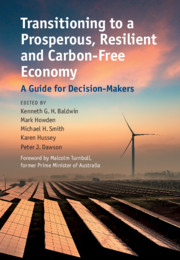Book contents
- Transitioning to a Prosperous, Resilient and Carbon-Free Economy
- Transitioning to a Prosperous, Resilient and Carbon-Free Economy
- Copyright page
- Dedication
- Contents
- Figures
- Tables
- Contributors
- Foreword
- Introduction
- 1 Policy Frameworks and Institutions for Decarbonisation: The Energy Sector as ‘Litmus Test’
- Technologies for Decarbonising the Electricity Sector
- 2 Wind Energy
- 3 Solar Photovoltaics
- 4 Solar Thermal Energy
- 5 Nuclear Energy
- 6 Hydropower
- 7 Energy Storage
- 8 The Hydrogen Economy
- Example Economies
- Cities and Industry
- Land Use, Forests and Agriculture
- Mining, Metals, Oil and Gas
- Addressing Barriers io Change
- Index
- References
5 - Nuclear Energy
from Technologies for Decarbonising the Electricity Sector
Published online by Cambridge University Press: 08 October 2021
- Transitioning to a Prosperous, Resilient and Carbon-Free Economy
- Transitioning to a Prosperous, Resilient and Carbon-Free Economy
- Copyright page
- Dedication
- Contents
- Figures
- Tables
- Contributors
- Foreword
- Introduction
- 1 Policy Frameworks and Institutions for Decarbonisation: The Energy Sector as ‘Litmus Test’
- Technologies for Decarbonising the Electricity Sector
- 2 Wind Energy
- 3 Solar Photovoltaics
- 4 Solar Thermal Energy
- 5 Nuclear Energy
- 6 Hydropower
- 7 Energy Storage
- 8 The Hydrogen Economy
- Example Economies
- Cities and Industry
- Land Use, Forests and Agriculture
- Mining, Metals, Oil and Gas
- Addressing Barriers io Change
- Index
- References
Summary
Nuclear power is a proven low greenhouse emission technology for electricity production that directly substitutes for fossil fuels. The current status of nuclear power worldwide is reviewed. Nuclear technology is described, beginning with an overview of the nuclear fuel cycle and the basic science of fission and energy production. The technology of nuclear fuel production, including enrichment, is outlined. Reactor technology alternatives are discussed in terms of both the current world fleet of reactor types and the future Generation IV technology to be deployed beyond 2030. The current status of small modular reactors (SMRs) under development is reviewed. SMRs are suitable for small countries or remote sites and have smaller up-front construction costs. The thorium cycle is seen as a potential technology for deployment towards the end of the century. Strategies for nuclear waste management and reactor decommissioning are described. Government, legal, regulatory and managerial support is needed to comply with internationally accepted safety standards, security guidelines and safeguards requirements. An independent nuclear regulatory organisation is essential.
Keywords
- Type
- Chapter
- Information
- Transitioning to a Prosperous, Resilient and Carbon-Free EconomyA Guide for Decision-Makers, pp. 105 - 124Publisher: Cambridge University PressPrint publication year: 2021

